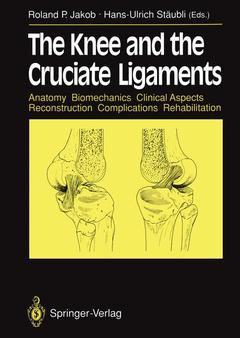Terms, Definitions, and Glossaries.- Historical and Current Perspectives in the Treatment of Anterior Cruciate Ligament Insufficiency.- Anatomy and Biomechanics.- Surgical Anatomy of the Knee Joint.- The Popliteus Muscle.- Structural Molecules in Articular Cartilage, Tendons, and Ligaments.- Functional Anatomy of the Cruciate Ligaments.- Anatomy and Biomechanics of the Anterior Cruciate Ligament: A Three-Dimensional Problem.- Significance of Anatomy and Biomechanics.- OAK Knee Documentation and Evaluation.- OAK Knee Evaluation: A New Way to Assess Knee Ligament Injuries.- Evaluation of Knee Ligament Injuries: The OAK and IKDC Forms.- Diagnosis, Pathomechanics, and Pathomorphology of Anterior Cruciate Ligament Insufficiency.- Diagnosis of Acute Tears of the Anterior Cruciate Ligament, and the Clinical Features of Chronic Anterior Instability.- Pathomechanical and Clinical Concepts of the Pivot Shift Phenomenon.- Anterior Subluxation in Knees with Chronic Anterior Cruciate Ligament Insufficiency: A Comparison of Arthrometry and Stressradiography.- Our Current Technique of Stressradiography Near Extension.- Anterior Subluxation in the Chronically Anterior Cruciate Ligament-Deficient Knee: Comparison of Simultaneous Arthrometry and Stressradiography Using the KT1000.- The Various Faces of Anterior Cruciate Ligament Tears During Arthroscopic Examination.- New Imaging Techniques.- The Drawer Simulator: A Practice-Oriented Training Device for Anteroposterior Stability Testing in the Knee.- Morphology and Function of the Cruciate Ligaments in a Computer Simulation Model.- Production of Mechanical Knee Models for Training.- Femoropatellar Problems Associated with Anterior Cruciate Ligament Insufficiency.- Classification of Meniscal Tears Associated with Lesions of the Anterior Cruciate Ligament.- Natural History of Untreated Tears of the Anterior Cruciate Ligament.- Natural History of Associated Intraarticular Pathology in the Chronic Anterior Cruciate Ligament-Deficient Knee.- Aplasia of the Cruciate Ligaments.- Concepts and Experience in the Treatment of Anterior Cruciate Ligament Disorders.- Healing Processes.- Morphologic Ultrastructure of Repaired and Reconstructed Ligaments.- Indications for the Operative and Conservative Treatment of Cruciate Ligament Injuries.- Indications for Cruciate Ligament Reconstruction: A Recapitulation.- Acute Tears of the Anterior Cruciate Ligament.- Treatment of Acute Tears.- Primary Repair of Acute Ruptures.- Late Results after Primary Repair.- Avulsion Fractures of the Intercondylar Eminence in Adolescents: Pathophysiology, Case Material, and Late Results.- Dislocation of the Knee.- Injuries of the Collateral Ligaments and Menisc.- Instability of the Medial Collateral Ligament: Operative or Nonoperative Treatment?.- Treatment of Combined Injuries of the Anterior Cruciate Ligament and Medial Collateral Ligament Complex.- Meniscus Repairs.- Meniscus Repair with Special Reference to Arthroscopic Technique.- Open Meniscus Repair: Technique, Postoperative Treatment, and Results.- Chronic Insufficiency of the Anterior Cruciate Ligament.- Autologous or Allogeneic Reconstruction?.- Arthroscopically Assisted Reconstruction of the Anterior Cruciate Ligament. Preoperative Planning: Two-Tunnel Technique.- Reconstruction of the ACL with a Patellar Tendon Graft Based on the Infrapatellar Fat Pad: An Experimental Study in Animals.- Use of the Semitendinosus Tendon for Anterior Cruciate Ligament Reconstruction.- Anterior Cruciate Reconstruction Through a Transligamentous Approach.- Modification of the Clancy Patellar Tendon Reconstruction of the ACL: Analysis of Three-Year Results.- Surgical Treatment of Anterior Cruciate Ligament Insufficiency: Comparison of Results of Repair, Primary Augmentation, and Reconstruction.- Late Results after ACL Reconstruction with an Autologous Free Patellar Tendon Graft.- Extraarticular Lateral Reconstructions.- Arthroscopic Techniques of Anterior Cruciate Ligament Reconstruction.- Kenneth Jones Technique of Arthroscopic Cruciate Reconstruction.- Arthroscopically Assisted Cruciate Ligament Reconstruction Using a Free Patellar Tendon Graft.- Arthroscopically Assisted ACL Reconstruction Using Autologous Quadriceps Tendon.- Cruciate Reconstruction under Arthroscopic Control: Technique and Preliminary Results.- Injuries of Posterolateral Structures and the Posterior Cruciate Ligament.- Lateral and Posterolateral Rotatory Instability of the Knee.- The Popliteus Tendon and Its Fascicles in the Popliteal Hiatus: Arthroscopic Functional Anatomy with and without ACL Insufficiency.- Synthetic Materials for Ligament Reconstruction.- Biomechanical Considerations.- Current Status of Synthetic Ligament Reconstruction.- Synthetic Augmentation of Anterior Cruciate Ligament Repairs and Reconstructions.- Instability and Osteoarthritis.- Instability-Related Osteoarthritis: Special Indications for Osteotomies in the Treatment of the Unstable Knee.- Monopodal Weight-Bearing Radiography of the Chronically Unstable Knee.- Role of Unicompartmental Arthroplasty in Femorotibial Osteoarthritis with a Deficient Central Pivot.- Complications of Anterior Cruciate Ligament Reconstruction.- Intra- and Postoperative Complications.- Role of Arthroscopy in the Diagnosis and Treatment of Complications of ACL Reconstruction.- Rehabilitation and Evaluation.- Aspects of Rehabilitation in the Anterior Cruciate L.ig ament-Deficient Knee.- Functional Rehabilitation after Anterior Cruciate Ligament Reconstruction.- Isokinetic Testing to Evaluate Quadriceps and Hamstring Strength after a Primary Anterior Cruciate Ligament Repair or Reconstruction.- Concluding Remarks.- Rationale and Benefit of Treating Cruciate Ligament Lesions: The Payer’s Perspective.- Future Outlook.




